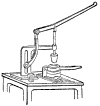winds threads of glass in opposite directions upon any surface. The amber
ware, so popular of late, shaded into ruby on one end, is a curious product
which was long held as a precious alchemistic secret by the glass trade.
The amber color is produced from common flint-glass by mixing a fine
solution of gold with the "metal." When the amber glass becomes cold and
is reheated it turns to a ruby red. Therefore, by exposing one end of the
vase or goblet of amber glass to the flame, that extremity is changed to
a rich red color, fading back into the unaltered amber.
Yonder two men have a mass of fiery glass as large
as their heads between them, each supporting it by a long rod. They carry
it off to one corner and walk away from each other, drawing it out into a
long rope, which you expect to see the boys jump over. But they soberly
keep to their work, and when it is all drawn out they lay it down in a wooden
trough, and cut it off into bars of even length. These are going to a glass
button factory, where they are reheated and pressed by moulds into the
dress-maker's materials. Glass tubes are drawn out in the same way from
a mass which has been blown hollow.
In another direction you notice one the
pressing-machines which American invention has added to the improvement of
the glass trade.

PRESS FOR PRESSED GLASS.
|
The plastic glass is dropped into a cast-iron mould, and
forced by hand-pressure into the fixed shape within. In this way most of
the cheapest glass objects of common hues are made-- dishes, inkstands,
lamps, etc. Imitation cut glass is one of the common products of the
pressing-machine. But it can always be distinguished from the genuine
expensive article by the inferior lustre and the unavoidable rounded edges.
In decanters and cruets the deception is heightened by using real cut-glass
stoppers. Sometimes the facets of pressed glass are cut, but they always
lack the brilliancy of true cut glass.
The most brilliant forms of transparent flint-glass,
or "crystal," are those blown
|
into the general shape desired-- dishes, globes, bottles, etc.-- and cut
into groups of glistening facets. This cut glass is slowly ground into
its angular patterns on stone wheels on which moist sand drips continually
from above. The polishing is completed by finer grains of sand, and by
wooden wheels supplied with emery, and finally putty powder. These
grinding-mills also remove the punty marks on tumblers, wineglasses, etc.
"Ground glass" is made by touching the surface to one of these wheels,
or by the application of sand in a blast or with water. The roughing of
bottle-neck interiors is done by iron tools fixed on a lathe and moistened
with sand and water. Copper disks engrave fancy designs that ornament fine
goblets and shades. Etched or embossed glass is made by submitting the
glass to the biting of hydrofluoric acid, the unetched portion of the
glass being protected by a coating of wax or some pitchy substance.
The best wages in the glass industry are received
by the window-glass blowers, sometimes reaching twelve dollars per day.
The master-melters rank next, though they seldom get more than half that
amount. From these earnings the prices slope down to the small tending
boys, who are paid thirty cents for ten hours' work. The blower's
occupation is laborious, but not unhealthful. He works eight or ten hours
at a stretch, finishing one melt of glass. There are four or five melts
every week, each requiring sixteen hours to fuse, ten hours of blowing, and
ten hours of flattening. The work is always by the piece, and in teams or
in "shops," each composed of one master-workman and several younger
assistants. There are in operation about 160 furnaces, at which there
are employed about 4000 blowers, gatherers, flatteners, and cutters. They
are bound together by a union that dictates the quantity each workman may
make, the number of apprentices that may be taken (generally not more than
two to a furnace), that prohibits any foreign workman from getting a place
in the factories, or any glass from being made in the months of July and
August. The average time they have worked in the last four years has
been less than eight months and a half. Much of the time lost has been
spent in strikes or disputes with the manufacturers about wages.
|